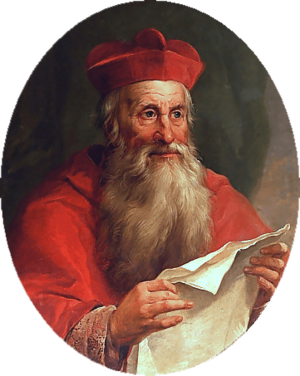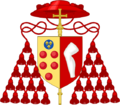Stanislaus Hosius facts for kids
Quick facts for kids Servant of God Stanislaus Hosius |
|
|---|---|
| Prince-Bishop of Warmia | |

Portrait by Marcello Bacciarelli
|
|
| Archdiocese | Bishopric of Warmia |
| Appointed | 2 March 1551 |
| Enthroned | 11 May 1551 |
| Reign ended | 5 August 1579 |
| Predecessor | Tiedemann Giese |
| Successor | Marcin Kromer |
| Other posts |
|
| Orders | |
| Ordination | 1543 |
| Consecration | 23 March 1550 |
| Created Cardinal | 26 February 1561 |
| Rank | Cardinal-Priest |
| Personal details | |
| Birth name | Stanisław Hozjusz |
| Born | 5 May 1504 Kraków, Kingdom of Poland |
| Died | 5 August 1579 (aged 75) Capranica Prenestina, Papal States |
| Nationality | Polish |
| Denomination | Roman Catholic |
| Parents | Ulrich Hosse of Pforzheim |
| Previous post |
|
| Education | |
| Coat of arms | |
Stanislaus Hosius (born Stanisław Hozjusz) was an important Polish leader in the Roman Catholic Church. He lived from 1504 to 1579. He became a cardinal, which is a high-ranking official in the Roman Catholic Church. From 1551, he was the Prince-Bishop of Warmia, a region in Poland. He also served as a special representative for the Pope, called a papal legate, in places like Vienna, Austria, and Poland.
Contents
Early Life and Education
Where Stanislaus Hosius Grew Up
Stanislaus Hosius was born in Kraków, a city in the Kingdom of Poland. His father was Ulrich Hosse from Pforzheim. Stanislaus spent his younger years in Kraków and Vilnius.
Learning and Studying
By the age of fifteen, he was already good at German, Polish, and Latin. He went to the University of Kraków and earned his Bachelor of Arts degree in 1520.
Piotr Tomicki, who was the Bishop of Kraków, hired Stanislaus as his private secretary. Bishop Tomicki also helped Stanislaus with his studies. He paid for Stanislaus to study at the University of Padua and the University of Bologna in Italy. At Bologna, he studied law with Hugo Buoncompagni, who later became Pope Gregory XIII.
Career and Church Leadership
Becoming a Royal Secretary
In 1534, Stanislaus earned his law degree from the University of Bologna. He then returned to Kraków and became a secretary for the king. After Bishop Tomicki passed away, Stanislaus continued to work as a secretary for the new vice-chancellor.
Later, he became a royal secretary for King Sigismund. The king trusted him completely and gave him many church positions as a reward for his loyal service. In 1543, Stanislaus Hosius became a priest.
Becoming a Bishop
In 1549, Stanislaus was chosen to be the Bishop of Chełmno. He didn't seek this important role and accepted it with some hesitation. King Sigismund sent him on an important diplomatic trip. He visited the courts of King Ferdinand I and Emperor Charles V. This trip helped create an alliance between Poland and other kingdoms.
When he returned to Poland, he became a bishop on March 23, 1550. He was a strong supporter of the Jesuits and actively worked against the Protestant Reformation.
Leading the Warmia Region
Two years later, he became the Prince-Bishop of Warmia in Royal Prussia, Poland. He wrote an important document called the Confessio fidei christiana catholica. This document was accepted by a church meeting in 1557. Stanislaus was a very skilled diplomat and manager. He and Marcin Kromer were key in keeping the Warmia region Catholic. This was important because the nearby Ducal Prussia had become Protestant.
Working with the Pope
In 1558, Pope Paul IV called him to Rome. Stanislaus soon became an important member of the Pope's advisory group, known as the Roman Curia.
The next year, Pope Pius IV made Stanislaus his personal representative to Ferdinand I, Holy Roman Emperor, in Vienna. His job was to help restart the Council of Trent, a major meeting of church leaders. He also needed to get the support of the emperor's son, Maximilian, who seemed to have some Protestant ideas.
For his successful work, Stanislaus Hosius was made a cardinal in 1561. Pope Pius IV also named him a special expert for the third session of the Council of Trent.
Role at the Council of Trent
Even though he had health problems, Stanislaus helped settle disagreements between different groups at the Council. He also dealt with issues specific to Poland-Lithuania. When the Council ended, he returned home. He left Trent in December 1563 to put the Council's decisions into practice in his own region. In 1566, Pope Pius V made him the Pope's special representative to Poland.
Later Life and Impact
Founding a School
Besides handling many difficult negotiations, Stanislaus Hosius founded a school called the lyceum of Braunsberg. This school was created to help stop the spread of Protestantism. It became a central place for the Catholic mission among Protestants.
Final Years
In 1572, Pope Gregory XIII made Hosius a member of an important church group called the Congregatio Germania. Stanislaus Hosius passed away near Rome on August 5, 1579.
Friends and Writings
Saint Peter Canisius was a special friend to Hosius. Both Hosius and Marcin Kromer left behind many records of their speeches and sermons in German. These were later translated into Czech, English, and French. A collection of his works was published in Cologne, Germany, in 1584.
Path to Sainthood
The process to recognize Stanislaus Hosius as a saint began but was paused for a while. It started again on August 5, 2006. He is now known as a Servant of God, which is the first step towards becoming a saint in the Catholic Church.
See also
- Theatre of the Virtues of the Venerable Stanislaus Hosius – a collection of 105 drawings by the engraver Tomasz Treter, showing scenes from Hosius's life.
Images for kids


